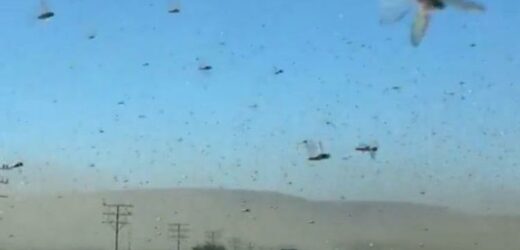South Africa: Car drives through locust swarm
We use your sign-up to provide content in ways you’ve consented to and to improve our understanding of you. This may include adverts from us and 3rd parties based on our understanding. You can unsubscribe at any time. More info
According to one observer, these locusts have made the conditions on the road “feel like a horror movie”. Several provinces of the country have been placed on high alert, and the crop-munching pests continued to cause panic on Wednesday.
Car drivers have been advised not to drive with their wipers on as this will likely smear the locusts across the windshield and reduce visibility even further.
According to local media, the brown locust infestation that plaguing much of South Africa has already cost the government millions of Rands as they try to combat the insects.
The South African National Department of Agriculture said in a written reply to Parliament that fighting the plague has already cost it more than R74,6m (£3.4million).
This figure includes the cost of appointing and training contractors, as well as the cost of insecticides and related safety material.


According to JacardaFM, Noupoort, Middelburg, and Colesberg seem to be bearing the brunt of this infestation, and these locust swarms now pose a real danger to drivers.
These locust attacks are likely going to cause food shortages in the country, as the bugs tend to destroy crops.
Last year, the UN warned that 25 million people in the east Africa region could be affected as South Sudan was suffering from a fresh wave of locusts.
According to the UN, a locust swarm of one square kilometre in size can eat the same amount of food in a day as 35,000 people.

Videos of highways filled with insects terrified people as many took to the internet to express their fear.
One person described the locust infestation as “biblical”, comparing it to the infamous plague.
Another person helpfully tweeted out: “Pro tip – to make it easier to remove all the squished insect bits from the front end of your vehicle once home, spray liberally with Mr Muscle kitchen cleaner, let soak for a few minutes and then wipe off….this will save a lot of elbow grease, trust me.”
DON’T MISS:
Omicron warning issued as ‘organ complications’ linked to Covid [REVEAL]
EU ‘sleepwalking’ into Putin’s energy crisis [INSIGHT]
Scientists warn that solar storms can threaten life on Earth [SPOTLIGHT]


One user suggested: “The copious rains must have something to do with the locust swarming”.
According to Moses Muli, a social and conservation expert, locust swarms tend to occur when a prolonged drought is followed by heavy rains.
Ezra Kipruto Yego, the Sustainable Development Goal coordinator of the UN Sustainable Development Solutions Network believes that there is a link between climate change, extreme weather events and locust swarms, particularly in East Africa.
The BBC reported him saying that when last year’s cyclones in the Indian Ocean made landfall, they may have created a suitable environment for locusts to infest into the region from their nesting sites in the Middle East.
Source: Read Full Article


